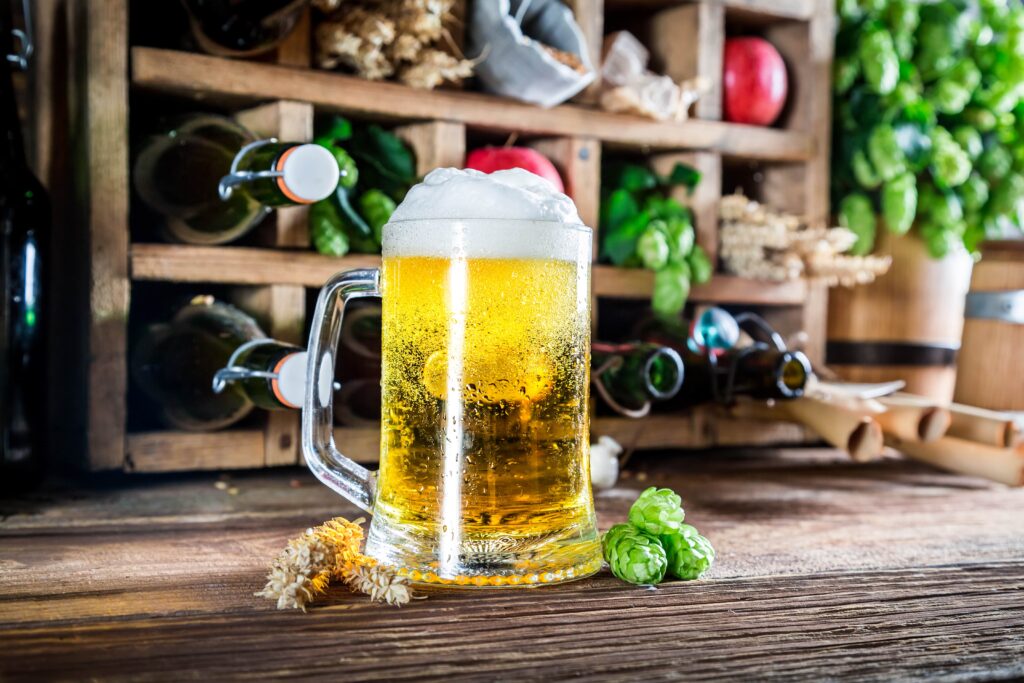Brewing beer is both an art and a science. If you’re getting hands-on experience with craft beer as a hobby, you may have noticed how many components there are in the brewing process. Learning those components is important for moving from casual beer drinking to expert tasting and brewing.
One element in particular is surprising to many drinkers, causing a buttery flavor in beer: diacetyl. Diacetyl is a natural byproduct of yeast metabolism during fermentation, which is necessary to make beer. It’s even present in many wines. Craft brewers, like the ones at our brewpub in Cincinnati, must understand how diacetyl during fermentation affects the desired flavor profile for our increasingly beer-smart consumers. While small amounts of diacetyl flavor can add nuances and complexity to a beer, too much of it can create an unpleasant flavor. Additionally, a suspect amount of beer diacetyl can point to an issue during the fermentation process.
Let’s take a look at diacetyl’s role in the brewing process and the tools and techniques available to control its presence and ensure the quality of craft beer.
Understanding Diacetyl in the Beer-Making Process
We know that diacetyl results in a butter flavor, but how does it appear in beer in the first place? Diacetyl belongs to a group called ketones, small organic compounds. When lager brewers add yeast to beer, it goes through a slow startup phase and a fast growth phase, creating byproducts it needs, like amino acids and proteins. One of these byproducts is an amino acid called valine. Yeast creates acetolactate as part of the process of making valine, but this acetolactate can then leak out into the beer and result in the formation of diacetyl through oxidation.
Certain ingredients and processes, such as fermentation conditions like higher temperatures and a lack of enough yeast nutrients, can result in higher levels of diacetyl in beer. The same goes for the strain of yeast used.
Diacetyl is released and reabsorbed later in the process, elongating the brewing process and costing the brewer time and money, so brewers try to control it for cost-effectiveness and to achieve the desired flavor with diacetyl tests.
Yeast Strains That Produce More Diacetyl
Not all healthy yeast strains produce the same diacetyl content. Some produce higher levels, like top-fermenting ale yeast strains. Not all ale yeast strains produce diacetyl equally, either. English ale strains produce more than American ale ones, so brewers take all of this into account to produce the correct aromas and flavors in their beers. Which flavors are they trying to avoid? Glad you asked! Let’s look at which off-flavors diacetyl produces in beer.
Off-Flavors Caused by Diacetyl in Beer
There are a variety of compounds in beers that cause off-flavors. For instance, isoamyl acetate causes a banana taste. Brewers are constantly keeping an eye on taste, bitterness, and other elements to ensure a high-quality beer.
Diacetyl’s presence in beer has varied responses. In moderation, diacetyl is desirable in stouts, English bitters, Scottish ales, and other ales. In other beers, it crosses a flavor threshold and becomes a red flag that there was an issue during brewing. Diacetyl’s butter and butterscotch off-flavors are unwanted in beer but are actually used in other products like food and e-cigarettes. Even chardonnay makers actively promote the production of diacetyl to make more buttery variations.
In an attempt to get beer to reabsorb the diacetyl, beer sometimes goes through a lager diacetyl rest, where the temperature is raised slightly after fermentation. This period allows yeast cells to reabsorb the diacetyl and prevent beer off-flavors. There are several ways to control levels of diacetyl. Let’s go through some.
4 Ways To Control the Levels of Diacetyl in Craft Beers
Ensuring a high-quality drinking experience will always be a craft brewer’s priority. Since diacetyl detracts from many intended flavor profiles and affects the drinker’s enjoyment, brewers try to control diacetyl levels using these four techniques throughout the brewing process. These include fermentation temperature, choosing yeast strains carefully, sanitizing equipment, and keeping tap lines clean.
1. Maintain the Right Yeast Fermentation Temperature
Higher temperatures during fermentation can lead to increased diacetyl production. Beer makers must carefully monitor and control temperatures to minimize diacetyl formation and ensure a cleaner beer flavor. This way, there is less diacetyl for the yeast to reabsorb later in the process.
2. Choose Yeast Strains Carefully and Perform Diacetyl Rests
Choosing yeast strains known for low diacetyl production helps prevent excessive amounts from showing up in your beer. Add to this strategy a diacetyl rest, where the beer is held at a slightly elevated temperature for a couple of days after fermentation. You’ll significantly reduce off-flavors in your beer. This step can improve beer quality for the drinker and keep the standards of your brewery high.
3. Sanitize Your Fermentation Equipment
Not only are proper sanitation practices of your fermentation equipment important for preventing contamination, but they can also prevent off-flavors, including those caused by diacetyl. Keeping fermentation vessels, hoses, and other equipment clean and sanitized will help maintain a clean brewing environment with no surprise contaminants in beer flavor.
4. Make Sure Your Tap Lines Are Clean
Diacetyl can still seep into your finished beer once it’s brewed if it’s poured through dirty tap lines. To prevent this issue, clean your tap lines and draft systems regularly.
By implementing effective control measures, brewers can minimize diacetyl production and maintain consistency in beer flavor. Each of these factors plays a crucial role in controlling diacetyl levels and ultimately producing superior craft beers that delight consumers.
Discover Masterfully Crafted Beers From Experienced Brewers
Now you know much more about the science and art of beer-making! Get into the craft beer Cincinnati scene with more blog posts like these and sip your way into your new hobby. We love sharing our craft beer in Cincinnati and the knowledge our expert brewers have gained while making it. If you’re looking for Cincinnati breweries, Little Miami Brewing Company is a high-quality brewpub dedicated to producing exceptional beers that showcase vibrant flavors and a brew for every taste.




